Definition
A prokaryotic cell is a type of cell that does not have a true nucleus or membrane-bound organelles. Organisms within the domains Bacteria and Archaea are based on the prokaryotic cell, while all other forms of life are eukaryotic. However, organisms with prokaryotic cells are very abundant and make up much of Earth’s biomass.
Overview
Organisms that have prokaryotic cells are unicellular. They are called “prokaryotes.” The prokaryotic cell has several elements that allow it to function as a living organism. First, prokaryotes are covered in a cell membrane. This membrane allows them to create a specific environment within the cytosol that allows biochemical reactions to take place. Second, these cells house both loose DNA and ribosomes. Though ribosomes are organelles, they are not bound by a plasma membrane. Together, the DNA and ribosomes work to produce the proteins that the cells need to gather nutrients, reproduce, and even defend themselves in the face of predators or environmental changes!
Prokaryotic are much smaller than the smallest eukaryotic cells. In general, a prokaryotic cell is smaller because it has less DNA to create the proteins needed to make an ultra-efficient membrane. So, the cells reach a size where they can no longer import the number of nutrients they need for the volume of cytosol they contain. This is known as a surface-area-to-volume ratio limit. However, bacteria are much larger than viruses because they are actively carrying out the biochemical reactions of life within their cells.
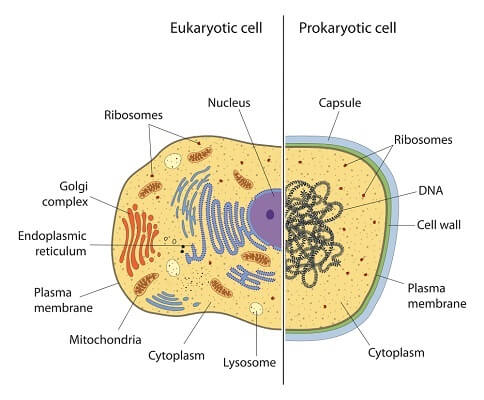
Prokaryotic Cell vs Eukaryotic Cell
The difference between the prokaryotic cell and the eukaryotic cell is simple. Eukaryotic cells have a nucleus surrounded by a nuclear membrane and other membrane-bound organelles that perform specific functions in the cell. These membranes form the endomembrane system, which creates a series of specialized chambers within eukaryotic organisms that can complete a diverse range of tasks. By contrast, a prokaryotic cell only has a cellular membrane with no membranes extending on the inside of the cell.
All of the reactions within a prokaryote take place within the cytosol of the cell. While this makes the cells slightly less efficient, prokaryotic cells still have a remarkable reproductive capacity. A prokaryote reproduces through binary fission, a process that simply splits duplicated DNA into separate cells. Without any organelles or complex chromosomes to reproduce, most prokaryotic cells can divide every 24 hours, or even faster with an adequate supply of food.
While many prokaryotic cells have adapted to free-living within the environment, others have adapted to live within the gut of other organisms. These commensal organisms survive by breaking down molecules inside the gut and allow the organism they are living within the ability to digest a wider variety of foods. For example, the human gut contains 2-3 pounds of bacteria that have evolved to help us digest complex carbohydrates, proteins, and fats.
Prokaryotic Cell Diagram
The following image is a diagram of a prokaryotic cell; in this case, a bacterium.
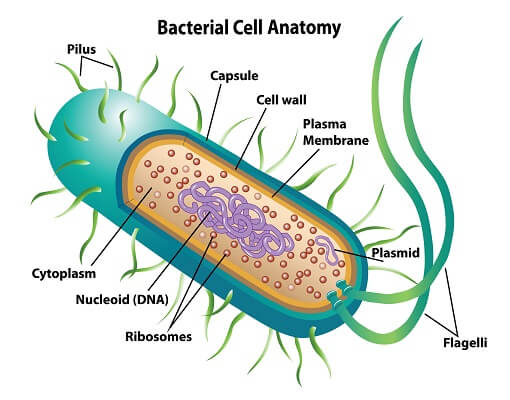
Prokaryotic Cell Structure
Prokaryotic cells do not have a true nucleus that contains their genetic material as eukaryotic cells do. Instead, prokaryotic cells have a nucleoid region, which is an irregularly-shaped region that contains the cell’s DNA and is not surrounded by a nuclear envelope. Some other parts of prokaryotic cells are similar to those in eukaryotic cells, such as a cell wall surrounding the cell (which is also found in plant cells, although it has a different composition).
Like eukaryotic cells, prokaryotic cells have cytoplasm, a gel-like substance that makes up the “filling” of the cell, and a cytoskeleton that holds components of the cell in place. Both prokaryotic cells and eukaryotic cells have ribosomes, which are organelles that produce proteins, and vacuoles, small spaces in cells that store nutrients and help eliminate waste.
Some prokaryotic cells have flagella, which are tail-like structures that enable the organism to move around. They may also have pili, small hair-like structures that help bacteria adhere to surfaces and can allow DNA to be transferred between two prokaryotic cells in a process known as conjugation. Another part that is found in some bacteria is the capsule. The capsule is a sticky layer of carbohydrates that helps the bacterium adhere to surfaces in its surroundings.
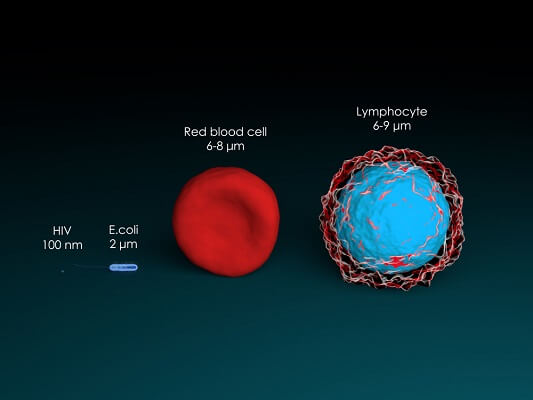
Prokaryotic Cell Parts
Unlike eukaryotic cells, prokaryotic cells have no distinct organelles bound by membranes. Instead, the many reactions the cell conducts happen within the cytoplasm of the cell. In fact, there are 2 main components that are present within all prokaryotic cells.
The first is a cell membrane. This is a layer of phospholipid molecules that separate the inside of the cell from the outside. While not present in all prokaryotes, many secrete a cell wall used to protect and house the cell in an extra layer of proteins and structural molecules.
The second part found in all prokaryotic cells is DNA. DNA is the basic blueprint for all life and is found within all cells. In prokaryotes, the DNA often takes the form of a large circular genome. This can be compared to the organized chromosomes which are typically found within eukaryotes. This large circle of DNA directs which proteins the cell creates, and regulates the actions of the cell.
Other prokaryotic cells can have a large number of different parts, such as cilia and flagella to help them move around. While these structures are similar in function to those found within eukaryotes, they often have a different structure. This suggests that the two types of cells have undergone very different selection processes and have independently involved the structures.
Characteristics of Prokaryotic Cells
All prokaryotic cells have a nucleoid region, DNA and RNA as their genetic material, ribosomes that make proteins, and cytosol that contains a cytoskeleton that organizes cellular materials. However, prokaryotic organisms are a very diverse group of organisms and come in many different shapes and sizes. These changes in structure typically represent changes in function, and these many different organisms occupy very different niches.
Prokaryotic cells are usually between 0.1 to 5 micrometers in length (.00001 to .0005 cm). Eukaryotic cells are generally much larger, between 10 and 100 micrometers. Prokaryotic cells have a higher surface-area-to-volume ratio because they are smaller, which makes them able to obtain a larger amount of nutrients via their plasma membrane.
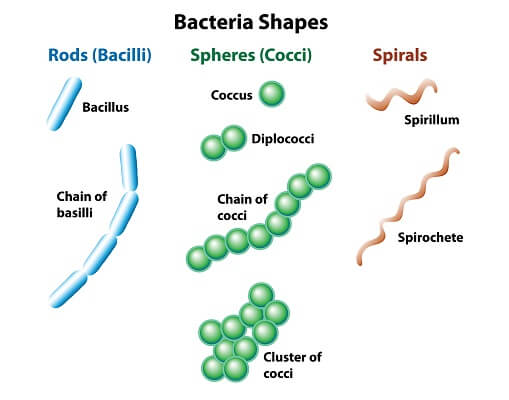
Examples of a Prokaryotic Cell
Bacterial Cells
Bacteria are single-celled microorganisms that are found nearly everywhere on Earth, and they are very diverse in their shapes and structures. There are about 5×1030 bacteria living in many different ecosystems on Earth (including in our own bodies). In the human gut, bacteria outnumber human cells 10:1.
The cell walls of some bacteria contain peptidoglycan, a molecule made of sugars and amino acids that gives the cell wall its structure and is thicker in some bacteria than others. Bacteria contain certain structures unique to them as previously mentioned, such as the capsule, flagella, and pili. Most bacteria have just one chromosome that is circular, which can range from about 160,000 base pairs (bp) to 12,200,000 bp. They also contain plasmids, which are small circular pieces of DNA that replicate independently of the chromosome.
Some bacteria can form endospores. These are tough, dormant structures that the bacteria can reduce themselves to under starvation conditions when not enough nutrients are available. They do not need nutrients and are resistant to extreme temperatures, UV rays, and chemicals. When environmental conditions become favorable again, the endospore can reactivate.
Archaeal Cells
Archaea are similar in size and shape to bacteria, and they are also unicellular. Since bacteria and archaea are the two types of prokaryotes, this means that all prokaryotes are unicellular. Some archaea are found in extreme environments, such as hot springs, but they can be found in a variety of locations, such as soils, oceans, marshlands, and inside other organisms, including humans.

Like bacteria, archaea can have a cell wall and flagella. However, the structure of these organelles is different. For example, archaeal cell walls do not contain peptidoglycan. In addition, the flagella of archaea work the same way as those of bacteria, but they evolved from different structures. Membranes of archaea are very different than those of all other lifeforms; they contain different lipids, which have a different stereochemistry. Archaea usually have one circular chromosome, as bacteria do. The archaeal chromosome can range from less than 491,000 bp to about 5,700,000 bp. They can also contain plasmids. Less is known about archaea than bacteria; they were not classified as a separate group of prokaryotes until 1977.
How do Prokaryotic Cells Divide?
Prokaryotic cells divide through the process of binary fission. Unlike mitosis, this process does not involve the condensation of DNA or the duplication of organelles. Prokaryotic cells have only a small amount of DNA, which is not stored in complex chromosomes. Further, there are no organelles so there is nothing to divide.
When a prokaryote grows to a large size, the process of binary fission takes place. This process duplicates the DNA, then separates each new strand of DNA into individual cells. This process is simpler than mitosis. This means that bacteria can reproduce much faster than most eukaryotic organisms.
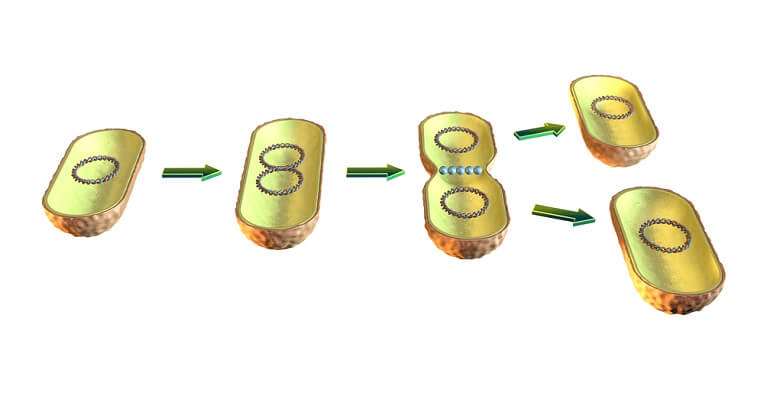
Quiz
